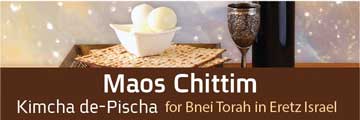Question:
1. If someone buys a house for $200,000, puts down $50,000 in equity, takes out a mortgage for $150,000, and then receives rent on the house for several years, how should he calculate his maaser? (Note: The mortgage payment includes tax, interest, and some repayment of the principal.)
2. If the person subsequently sells the house for $400,000, how should the maaser be calculated? I would think that the initial equity, any remaining taxes, and interest not already deducted when maaser was paid on the rental income can be deducted from the profit on the sale. But what about the principal of the mortgage? Does the person have to pay maaser on the $150,000 value of the house? What about any home improvements (e.g., painting)?
Answer:
1. In order to fulfill the custom of maaser kesafim, one should give maaser from all one’s income. This includes business profits, interest on loans to nochrim, salary, ((Salary calculations for purposes of maaser kesafim can be based on the net salary. If income tax is withheld, it does not have to be taken into consideration. National Insurance contributions do not have to be considered part of your salary either. When National Insurance pays benefits (e.g., child allowances, maternity leave, or disability), the benefit should be considered maaserable income at that time. If the National Insurance payment was put into a separate fund (e.g., for your children) and yielded interest, when you (or your children) draw from that account the beneficiaries should consider whether they wish to pay maaser kesafim. Similarly, if money is taken out of your salary and put into a retirement fund, you can defer your maaser on that amount until the fund starts yielding income. However, if you decide to do things that way, whoever takes the maaser will have to calculate the principal paid by National Insurance or monies put into the retirement fund and take maaser from the principal, too. If maaser is taken immediately from the amount paid by National Insurance or put into the retirement fund, when you calculate the maaser later you have to deduct the amount put in and pay maaser on the profit only. Money withheld to pay for kupat cholim (health care) should be added to the net salary before the 10% is calculated. This amount has to be maasered, since it will be converted into services and will not be seen again as cash.)) rental income, gifts, ((אא”כ ניתן לו המתנה ע”מ שלא יעשר (עיין אג”מ יו”ד ח”ב סימן קי”ב). )) found items, ((שו”ת שאילת יעב”ץ ח”א סימן ג’ וסימן ו’ מחייב מעשר ממוצא מציאה, זוכה מהפקר וזוכה מנכסי הגר. )) and inheritance. ((כ”כ בא”ר סימן קנ”ו. והיינו אע”פ שהאב כבר הפריש מעשר מנכסיו, מ”מ כשיורש הבן המעות נתחייב שוב דאין חובה על הממון להתעשר אלא חובת הגברא שחייב לתת לצדקה ממה שחננו השי”ת. וכעי”ז כתב הט”ז ביו”ד של”א ס”ק ל”ב שממה שנתן אבי החתן נדוניא לבנו, חייב הבן לעשרו אף שהאב כבר עישר, ואין לומר שהממון כבר נפטר. )) One does not, however, have to give maaser from a loan received. ((בשאילת יעב”ץ (ח”א סימן ו’) דן בענין נכסי מלוג ונכסי צאן ברזל שהאשה מכנסת לבעלה, ואינו זוכה אלא בפירות אבל הוי עליו כחוב והלואה, והעלה דאין הבעל חייב להפריש מעשר מנ”מ ומנצ”ב אלא מהפירות שיבא לו מהם. ונראה דה”ה בכל הלואה.
ונראה דכשפורע חובו, צריך לפרוע ממעות מעושרים כבר.
ואם יש לו רווחים מההלואה שלוה נראה דיכול לנכות כל ההפסדים שהיה לו מההלואה כנגד הרווחים. כגון אם לוה מנכרי ושילם רבית או קבל המעות בהיתר עיסקא ושילם בדרך התפשרות סכום מסויים לפטור א”ע משבועה, יכול לנכות מריוח שלו. ולא עוד, אלא אפילו לא הרויח במעות הללו שלווה ורק היה צריך לשלם למלוה רבית או דרך התפשרות בהיתר עיסקא, נראה דיכול לנכות הפסדים אלו כנגד שאר רווחים שיש לו בענין אחר. ))
In the situation you describe, the $50,000 paid for the house should have already been maasered. The loan of $150,000 does not have to be maasered before it is used, but it should be repaid (principal, interest, taxes and other charges) with money that was already maasered. Only the rental income is maaserable. You can deduct all losses associated with the mortgage and the house from the rental income. (( The portion of the mortgage payments meant to repay the principal cannot be deducted as a loss, since it represents an asset that you are keeping. If you repay the mortgage with money that was already maasered, the house does not need to be remaasered, but you cannot consider the purchase price a loss and subtract it from the rental income. Therefore, the next few sentences in the text offer a formula for figuring out the maaserable income, taking into account that the mortgage payments include the principal. )) The interest, taxes and charges included in the mortgage payments are deductible, but the repayment of principal is not. (( The house is not considered income or a loss. You simply exchanged your maasered liquid assets (money) for real estate, i.e., you converted an asset from one form into another. The home is not considered a loss either, since it remains your property. )) It may be simplest to calculate how much of each mortgage payment is principal, subtract that amount from the mortgage payment, and then deduct the entire balance from the rental income. The difference is maaserable. At fixed intervals you should calculate the mortgage expenses that are beyond the principal and figure out the rental income for that period. Based on those figures you can calculate how much maaser to designate fortzedokoh. (( There are other ways of doing this. For example, if it is easier for you to use the entire mortgage payment as a deduction from the rental income, since every mortgage payment includes part of the principal, you will need to equalize the equation by adding the value of the principal to the income figure. (Since the true value of the house is not deductible as a loss since it remains your asset and by deducting the entire amount of the mortgage the principal is effectively being deducted, a correction needs to be made. That can be done by adding the value of the house as income. That would cancel out the incorrect deduction). This can be done by adding any fraction of the principal of the loan to the rental income before making the deduction. For example, if the mortgage was for 15 years, then you can add $10,000 to the rental income every year, and deduct the entire mortgage payments for that year. The balance will be maaserable. ))
2. Only the profit from the sale is maaserable. Assuming the $50,000 in equity paid was already maasered, (( It is appropriate to separate maaser first from the principal and afterwards from any profits or dividends the original income yields (Shach, Yoreh De’oh 249:2). )) and the balance of the purchase price was paid with borrowed money, the house itself does not have to be maasered. ((
The logic behind this is that it is not income, since there is an outstanding debt that has to be repaid. In other words, if it were considered income, there would be a corresponding and equal reduction in income due to the debt, effectively canceling out the loan for purposes of maaser.
This explains why the money received as a loan does not have to be maasered. But what about the equity of the house that is owned? Does maaser need to be paid on the house itself? The original $50,000 paid in cash was money that had already been maasered. Since the equivalent value in the house remains in your possession, that amount ($50,000 worth of the house) is already maasered and need not be remaasered. Similarly, all mortgage payments should be made with money that has already been maasered. Since payment of the principal is included in the mortgage payment, the remaining value of the house ($150,000) will have been paid with maasered money. Thus the entire house does not have to be maasered, since all you did was exchange a maasered cash asset for a real estate asset. )) The profit generated from owning the house (i.e., the rental income and profit from the sale of the house) is maaserable. If the selling price was $400,000 and the purchasing price was $200,000, the profit is $200,000. The maaser owed on the sale of the house is $20,000. As always, you can first deduct all expenses before calculating maaser. If there were taxes, interest payments or any other losses unrelated to the house, they can be deducted from the profit for the period being assessed. ((
ז”ל עה”ש יו”ד סימן רמ”ט ס”ז וכן הוא דבר פשוט שהריוח מחשבין בכל שנה ושנה מר”ה עד ר”ה, ואם בשנה זו היו לו עסקים שיש שהרויח בהם ויש שהפסיד בהם עושה חשבון כללי ומה שנשאר ריוח נותן מעשר לצדקה. ובכלל ריוח נחשב רק הריוח הנקי, וכל ההוצאות שהיה לו על העסק אף מה שנסע הוא בדרך ואכל ושתה הכל נחשב על הוצאות העסק ומנכה הכל, ומה שנשאר ריוח אחר ניכוי כל ההוצאות מקרי ריוח אבל הוצאות ביתו לא ינכה. ולכן מי שמרויח אלף זהובים לשנה נותן מאה או מאתים לצדקה אע”ג שהוא בעל הוצאה בביתו עוד יותר מאלף זהובים מ”מ חייב ליתן מעשר מהריוח, ורק מה שהיה צדקה בההוצאה כגון וכו’ לקח אורח עני על שבת וכו’ יכול לנכות מחלק המעשר, אבל הוצאות בניו ובנותיו הקטנים וכו’ אין זה בכלל צדקה וכו’ ואף המגדל בני בניו ובני בנותיו או בנותיהם נ”ל שאינו יכול לחשוב זה בכלל צדקה, אבל המגדל יתום ויתומה ממשפחתו או שלא ממשפחתו וודאי שהיא צדקה גדולה ויחשוב זה ממעות מעשר וכו’ עכ”ל.
ועיין בשו”ת חוות יאיר סימן רכ”ד שיכול לקבוע לעצמו יום מיוחד בכל תקופה כגון כל ג”ח או חצי שנה, ובאהבת חסד (פי”ח סי”ב) כתב שיעשה חשבון כל חצי שנה או בכל שנה, וכן בנו”ב תניינא יו”ד סימן קצ”ח פסק שכל הריוח וההפסד של כל השנה יכול לנכות זה מזה אבל לא משנה לחברתה. ))
If the $50,000 equity was not maasered, then you calculate $250,000 in profit minus all expenses and maaser the balance. (( Maaser means 10%. One may give up to 20% towards tzedokoh. It is appropriate to be quite meticulous with all maaser calculations (Chavos Yair 224; Ahavas Chesed 19:3, note). It is advisable to declare when accepting the praiseworthy custom ofmaaser kesafim that you plan to estimate the calculations. Then you do not have to be punctilious about the exact figures (Ahavas Chesed 19:3, note). ))
Should part of the difference between the selling price and the buying price be attributable to inflation and a general rise in the cost of living, it can be factored in. This will reduce the profit margin. For example, if the buying power of the dollar dropped 50% and the same type of house that was bought for $200,000 years ago now sells for $400,000, the entire change in price is due to the buying power of the dollar and it is not necessary to register any profit for purposes of maaser kesafim. ((
Rav Feinstein (Iggros Moshe, Y.D., vol. 2, 114) distinguishes between ribbisand maaser kesafim regarding inflation. With respect to the latter, he rules that one has to have a clear profit before giving tzedokoh and therefore one can factor inflation into the equation when determining if there was a clear profit. (The term clear profit means that you don’t only look at the purchase price and selling price and whatever the difference is should be viewed as profit. Rather, the inflation rate needs to be calculated and after the inflation is factored in, that new price is subtracted from the selling price and that is the clear profit).
However, he argues that it is not sufficient to look at the real estate market when evaluating whether inflation caused the change in the price of the house. One might have thought that the way to calculate inflation is to determine how much a house bought 10 years ago for $200,000 would cost today. If it would cost $400,000 and it was sold for $400,000, no tzedokoh must be given since there is no real profit. If the same type of house could be bought for $370,000 and it was sold for $400,000, then the profit is $30,000. This is not the case. Many factors affect the price of expensive items such as real estate. Inflation should be measured according to essential items that most people purchase regularly, such as food and basic household goods. The inflation rate for these staples should be applied to the real estate market in order to figure out the real profit.))
If the house was painted or underwent some other improvement, maaser does not have to be paid on the increase in value before the house is sold. However, once it is sold, maaser should be given on the profit from the sale, as mentioned earlier. The cost of the home improvement (e.g., painting) can be deducted from the profit for that period. In general, any costs expended in the hope of generating a profit are deductible. ((
Even if the money was spent in the hope of generating a profit, it is deductible (Beis Lechem Yehuda, gloss of Shulchan Aruch, Y.D. 249, in the name of Shevus Yaakov, vol. 2, 86). The underlying principle is explained by Chavos Yair (224).
Here are some practical applications:
- If a woman hires help so that she can go to work, the household help or babysitter is deductible from the household income.
- Income tax (Iggros Moshe, Y.D. 143; Minchas Yitzchok vol. 5, 34:9) and business tax are deductible.
- Rent and property tax for a business are deductible.li>
- Security and insurance are deductible. (If the insurance company pays out a claim, maaser does not have to be paid on the “income,” since this is considered a replacement of the item claimed and not new income. For example, if you bought a car with maasered money and then it was stolen, the insurance company will pay the value of the car so that you can replace the car. The money received reversed the temporary loss and you are now in the same position as before your car was stolen (Tzedokoh u’Mishpot, chap. 5, note 37). ))










